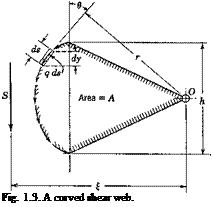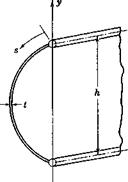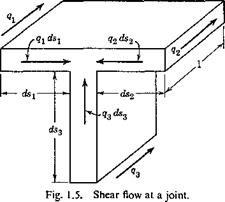The previous volumes of the GALCIT * series have included two on aerodynamics and two on structural analysis and elasticity. The present work combines elements from these two fields. The subject of aeroelasticity has received a rapidly increasing amount of attention during the past few years, and the recent literature has become very voluminous. However, practically all of the contributions to this literature have been in the form of scientific or technical papers dealing with specific problems. Very few books dealing with the subject as a whole have appeared, and it is believed that a work of this type would now be useful, even though the subject is still expanding rapidly. The present volume has been prepared with this in mind, and it is hoped that it will prove valuable both in connection with academic instruction and also to scientists and engineers working in the field.
Clark B. Millikan For the Editors
May 1955
* Guggenheim Aeronautical Laboratory, California Institute of Technology.
Trees sway in the wind; so may smokestacks. Flags and sails flutter; so may airplane wings and suspension bridges. The wind played ancient aeolian harps; so it plays the electric transmission lines, making them “sing” or even “gallop.” These, and other phenomena that reveal the effect of aerodynamic forces on elastic bodies form the subject matter of aeroelasticity. It is a subject of growing importance in many fields of engineering, particularly in aeronautics, where, in the last decade or so, with the ever-increasing aircraft size and speed, aeroelasticity has become one of the most important considerations in aircraft design.
Although aeroelastic phenomena occur in everyday life, the attempts to develop a theory toward their understanding were made essentially by aeronautical engineers. A serious study of aeroelasticity started in the early ’20’s and, at present, it is still a young science making rapid progress. Nevertheless, part of the theory has reached a classical stage, and a general treatment is now possible.
This book owes its existence to a course on aeroelasticity which has been given to students in aeronautics at the California Institute of Technology since 1948. It is intended primarily as a textbook, but it should be useful also to designers and flutter engineers, for h gives a composite picture of various aspects of aeroelastic problems.
As the subject relies so heavily on aerodynamics, elasticity, and mechanical vibrations, most of the fundamental concepts in these related branches of mechanics are briefly explained in Chapter 1. Those having a rudimentary knowledge of aerodynamics and strength of material should have no difficulty in reading it. In this brief review, an effort is made to stress a number of points of importance in aeroelasticity, such as the arbitrariness contained in the usual definitions of shear center, the meaning of elastic axis, the conditions under which influence coefficients are unsymmetrical, the spanwise phase shift in the torsional vibration of a cantilever beam with viscous damping. However, no attempt is made to present, in a detailed manner, all the methods of analyzing the elastic deformation of complicated structures, or their natural vibration modes. The basic reason is a desire to move as quickly as possible to the main topics of aeroelasticity, to bring out aeroelasticity’s main features in
contrast to those usually found in treatises on aerodynamics, elasticity, and mechanical vibrations.
The main body of the text is divided into two parts. Chapters 2 to 11 contain a survey of aeroelastic problems, their historical background, basic physical concepts, and the principles of analysis. Chapters 12 to 15 contain the fundamentals of oscillating airfoil theory, and a brief summary of experimental results.
The selection of material perhaps requires some explanation. In Chapter 2, some problems of common occurrence in civil and mechanical engineering are outlined.. The main character of these problems is that the structures concerned are not streamlined and are unamenable to theoretical treatment. One must rely chiefly on experimental results to understand the nature of aerodynamic forces. A wide variety of phenomena is described. These phenomena are likely to appear also in aeronautical engineering when unfavorable conditions are encountered, such as when a wing is stalled, or when it is situated in a turbulent flow. An understanding of these phenomena not only is important in itself but also provides a natural background for the linearized theory to be discussed in the following chapters.
Principal problems of aeronautical interest are developed in Chapters 3 to 11. The steady-state problems and flutter theory are treated along conventional lines. But in discussing the dynamic stresses in aircraft due to gusts or other dynamic loading, as well as buffeting and stall flutter, the statistical aspects are emphasized. I believe that some statistical concepts and techniques are of vital importance to a proper understanding of many dynamic-stress problems.
The theory of aeroelasticity is concluded in Chapter 11 with a general formulation and a brief discussion of the basic mathematical characteristics. It is hoped that this discussion will attract the attention of mathematicians toward the important field of non-self-adjoint equations, which, owing to certain inherent difficulties, are very much neglected in the mathematical literature. Although in the past most of the practically important problems in physics were governed by self-adjoint equations, it is now shown that the entire field of aeroelasticity would have to be based on non-self-adjoint equations. In aeroelasticity those problems that are reducible to self-adjoint systems are really exceptional. Thus, a new impetus exists for the study of non-self-adjoint equations.
The aerodynamics of oscillating airfoils presented in Chapters 12 to 15 is of an introductory nature, and includes only those topics that are required in reading this book. Many aspects of the unsteady airfoil theory are still undergoing rapid development, and it seems yet too early to give a complete account.
As this book is not intended to be a compendium or a handbook, attention is directed only to the fundamental principles. The physical assumptions involved in the mathematical formulation of a problem are always emphasized, so that the degree of approximation relative to the real physical system can be seen. In this way the reader will realize the directions in which future improvement may lie.
In order to limit the size of the book, I have refrained from going into detailed discussions on such topics as flight-flutter testing, control and stability of aircraft, swept-wing analysis, stochastic theory of buffeting, and applications of digital and analog computing machines. An attempt is made, however, to provide sufficient guidance to the existing literature, so that the reader may find proper references to the particular subjects of his own interest.
The list of references in this book is by no means complete. Only those that are believed to be readily accessible to the general reader are quoted. Papers published expressly for limited circulations are generally omitted. A few important papers appeared too late to be included in the bibliography. But the reader can easily obtain the most recent references from the journal Applied Mechanics Reviews.
In preparation of this book, I am indebted to many of my colleagues at the California Institute of Technology. The constant advice of Professor E. E. Sechler is gratefully acknowledged. Doctors H. Dixon, A. Kaplan, A. Roshko, W. H. Wittrick, С. M. Cheng, Y. J. Wu, and Professors M. L. Williams and G. Housner read part of the manuscript and offered many valuable comments. Mrs. Dorothy Eaton, Mrs. Betty Wood, Mrs. Virginia Boughton, Mrs. Virginia Sloan, and Mrs. Gerry Van Gieson helped the preparation of the manuscript. To them and to many other friends I wish to express my sincere thanks. To Dr.-Ing. H. Drescher of the Max-Planck Institute I am especially grateful for permitting me to use some illustrations from his research work. My wife, Luna Yu, helped in reading the manuscript and proofs, checking the equations, and working out examples. I have derived infinite encouragement from her enthusiasm and patience in working on this book.
This book is dedicated to the memory of my father.
Y. C. Fung
Pasadena
May 1955
CONTENTS
Introduction 1
1. Preliminaries 4
2. Some Aeroelastic Problems in Civil and Mechanical Engineering 60
3. Divergence of a Lifting Surface 81
4. Steady-State Aeroelastic Problems in General 113
5. Flutter Phenomenon 160
6. Fundamentals of Flutter Analysis 186
7. Engineering Flutter Analysis and Structural Design 246
8. Transient Loads, Gusts 272
9. Buffeting and Stall Flutter 310
10. Applications of Laplace Transformation 333
11. General Formulation of Aeroelastic Problems 365
12. Fundamentals of Nonstationary Airfoil Theory 381
13. Oscillating Airfoils in Two-Dimensional Incompressible Flow 395
14. Oscillating Airfoils in Two-Dimensional Compressible Flow 418
15. Unsteady Motions in General. Experiments. 444
Appendixes 471
Author Index 483
Subject Index 491
Aeroelasticity deals with the combined features of fluid mechanics and solid mechanics. Aircraft designers are concerned with aerodynamic performance of an elastic aircraft. Designers of bridges and skyscrapers need to know what the wind will be doing to their structures. Designers of artificial heart valves and students of medicine want to know how blood flows in very flexible vessels. Naturalists and environmentalists are interested in the locomotion of birds, fish, and mammals, or the swaying of trees and fluttering of leaves. Scientific study of these problems has to focus on flow in regions with deformable boundaries, and on the deformation of solids subjected to fluid loading, which varies with the deformation itself. The dynamics of these systems are often intricate, surprising, and important for the survival of man, machine, animals, and plants. I was involved in each of these areas at different periods of my life.
I entered college at the time of World War II and chose to study aeronautics because it seemed to be a topic relevant to national survival. After graduation I worked in the Chinese Institute of Aeronautical Research in Chengdu. One of my assignments was the preparation of a design manual of the control surfaces, and in that job I read about flutter. Then I received a scholarship and entered the California Institute of Technology in Pasadena. When my mentor, Professor Ernest Sechler, asked me what I would like to work on for my Ph. D. thesis, I said flutter. Dr. Sechler said that our Dr. Theodor von Karman used to have a research project on the flutter of suspension bridges sponsored by the State of Washington Bureau of Highways and Bridges after the wind-driven failure of the Tacoma Narrows Bridge. The cause of the failure was believed to be the von Karman vortex street. When Dr. von Karman retired, Dr. Maurice A. Biot took over the project. When Dr. Biot went back to Belgium, Dr. Louis Dunn continued in this research. But Dr. Dunn went to the Jet Propulsion Laboratory. “We have a wind tunnel built specially for the testing of suspension bridges. See what you can do with it.” So I played with models in that wind tunnel, focused on airplanes, and wrote my thesis, which was expanded later and became this book.
Then came the jets and spacecraft. I worked on flutter, control, wind and gust load, clear-air turbulence, stability and fatigue of aircraft structures,
fuel sloshing in space vehicles, landing impact, and ground shocks. I earned consulting fees on the analysis of wind load on the cantilevered roof of the University of Washington stadium in Seattle, and on methods to damp out wind-generated vibrations of a restaurant suspended under two arches at the Los Angeles Airport. By the 1960s, my interest was shifted to biomechanics. In 1966, I resigned my post at Caltech and went to the University of California at San Diego to start a bioengineering program in the School of Medicine. Many research problems in biomechanics are aeroelastic in nature. Indeed, at a meeting of the American Society of Zoologists, I found many zoologists are familiar with this book on aeroelasticity because it is a convenient reference for the non-stationary wing theory. For readers who are interested in biological applications of aeroelasticity, may I offer the following three books written by Y. C. Fung, and published by Springer-Verlag, New York: Biomechanics: Mechanical Properties of Living Tissues, 1st ed., 1981, 2nd ed., 1993. Biodynamics: Circulation, 1984. Biomechanics: Motion, Flow, Stress, and Growth, 1990. Also, the following book may be helpful: Y. C. Fung, A First Course in Continuum Mechanics, for Physical and Biological Engineers and Scientists, Prentice Hall, Englewood Cliffs, New Jersey, 3rd ed., 1993.
Y. C. Fung, La Jolla






















